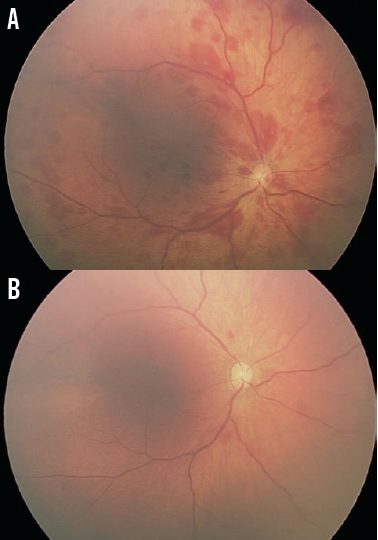Spontaneous Resolution of Neonatal Retinal Hemorrhages
A healthy, full-term infant was born by normal, vertex-position vaginal delivery with no evidence of cord strangulation or fetal distress. The pregnancy had been uncomplicated other than by prenatal maternal cocaine use, which prompted fundoscopic examination of the neonate on the first postnatal day. Profuse bilateral retinal hemorrhages were seen (A). There was no periventricular hemorrhage, subconjunctival hemorrhage, or evidence of bleeding tendency. The results of a complete blood count and coagulation studies were normal.
 A fundoscopic examination repeated after 7 days of life showed dramatic improvement, with spontaneous resolution of the hemorrhages (B).
A fundoscopic examination repeated after 7 days of life showed dramatic improvement, with spontaneous resolution of the hemorrhages (B).
Retinal hemorrhages are seen in up to one-third of healthy neonates.1 They are more common after assisted deliveries but also can occur after normal vaginal deliveries.2 Retinal hemorrhages reportedly are not more common after antenatal maternal cocaine use, despite its association with congenital abnormalities of the developing eye.3
Neonatal retinal hemorrhages generally are benign and usually resolve in 2 to 4 weeks. Documentation in the patient’s medical record of the disappearance of such hemorrhages is important in that it excludes not only pathologic causes, but also nonaccidental injuries, should such concern be raised in the child.1
References
1. Emerson MV, Pieramici DJ, Stoessel KM, Berreen JP, Gariano RF. Incidence and rate of disappearance of retinal hemorrhage in newborns. Ophthalmology. 2001;108(1):36-39.
2. Williams MC, Knuppel RA, O’Brien WF, Weiss A, Spellacy WN, Pietrantoni M. Obstetric correlates of neonatal retinal hemorrhage. Obstet Gynecol. 1993;81(5 pt 1):688-694.
3. Stafford JR Jr, Rosen TS, Zaider M, Merriam JC. Prenatal cocaine exposure and the development of the human eye. Ophthalmology. 1994;101(2):301-308.
Acknowledgement
The authors thank Kenneth D. Cocker, BSc, for his assistance with image processing, and Alistair R. Fielder, FRCP, FRCS, FRCOphth, for his valuable support.


